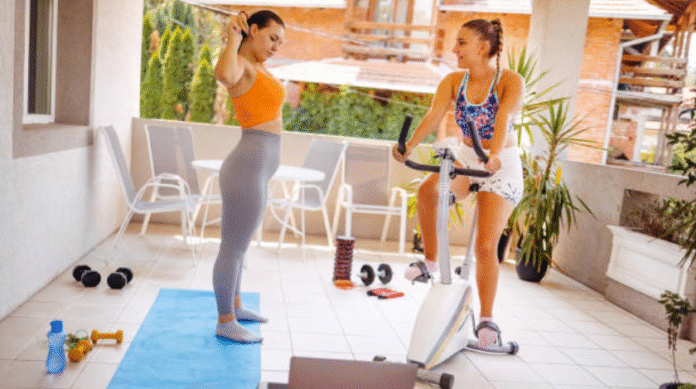Let’s be honest today’s fitness world is wildly different from what it was just a few years ago. Forget old-school gym memberships. Now, it’s all about convenience, customization, and tech-driven results. That’s where the buzz around Fitnara, home gyms, and even meteorology shops kicks in.
But hold on… what does weather have to do with your dumbbells and yoga mats? And how does Fitnara fit into all this? You’re about to find out.
Understanding Home Gyms
Why Are Home Gyms Becoming So Popular?
Let’s face it: commuting to the gym, waiting for equipment, and dealing with crowds is exhausting. With home gyms, you’re in control no waiting lines, no awkward small talk. Plus, you save money over time and can work out in your pajamas (no judgment here!).
Essential Equipment for a Functional Home Gym
You don’t need a full-blown fitness center. Here’s what gets the job done:
-
Adjustable dumbbells
-
Resistance bands
-
Yoga mat
-
Pull-up bar
-
Cardio gear (treadmill, bike, or rower)
-
A smart fitness tracker (more on that soon…)
Pros and Cons of Setting Up Your Own Gym
Pros:
-
Convenience
-
Cost-effective long term
-
Personalized space
-
Open 24/7
Cons:
-
Upfront cost
-
Space limitations
-
Motivation can dip without structure
The Role of Meteorology in Fitness
What Does Meteorology Have to Do with Working Out?
It might sound strange at first, but hear me out. Weather conditions can significantly affect your workout. Running on a humid day? You’ll fatigue quicker. Cold temps? Muscles take longer to warm up. Tracking weather helps you adjust your training smartly.
Climate’s Impact on Your Performance
Humidity, temperature, wind, and air pressure all these can either boost or sabotage your performance. For example:
-
High heat = risk of dehydration
-
Cold air = tight muscles
-
Low pressure = increased fatigue
Weather-Based Workout Planning
Apps and wearables (like Fitnara) are now integrating local weather data. That means:
-
Suggesting best times to work out
-
Modifying training based on air quality
-
Warning about UV exposure
What is a Meteorology Shop?
Tools You’ll Find in a Meteorology Shop
Surprisingly, meteorology shops aren’t just for scientists. They sell:
-
Barometers
-
Thermometers
-
Humidity sensors
-
Wind meters
-
UV Index monitors
Can It Benefit Fitness Enthusiasts?
Absolutely. A runner or cyclist could totally benefit from knowing the wind speed or pollen count before heading out. Even home gym users can track indoor humidity or air quality.
Evaluating Fitnara: A Complete Review
Overview of Fitnara’s Features
Fitnara isn’t just a fitness tracker it’s a full-on fitness assistant. It offers:
-
Real-time biometrics tracking
-
Weather syncing
-
Sleep analysis
-
Custom workout suggestions
-
AI-based performance coaching
Fitnara’s Data Tracking and Personalization
It learns your habits. After a few sessions, it adapts to your:
-
Preferred workout times
-
Recovery rates
-
Fatigue indicators
-
Even your weather preferences
How Accurate is Fitnara’s Technology?
It uses advanced biometric sensors combined with environmental data. Users report solid accuracy on heart rate, step counts, and even oxygen levels pretty impressive.
Real User Experiences
“I never thought weather would impact my workouts this much. Fitnara showed me how to train smarter, not harder,” says Tom, a marathon runner.
Comparing Fitnara With Competitors
Fitnara vs Fitbit
While Fitbit tracks steps and sleep well, Fitnara digs deeper. Think weather syncing, AI coaching, and performance forecasting a total game-changer.
Fitnara vs Apple Watch
Apple Watch is stylish and multi-functional, but Fitnara is focused. It’s a dedicated fitness beast with weather and performance synergy Apple doesn’t yet match.
Unique Selling Points of Fitnara
-
Real-time meteorology integration
-
Personalized recovery suggestions
-
Custom fitness plan creation
Integrating Meteorology with Fitnara
How Fitnara Adapts to Weather Patterns
If it’s too hot outside, Fitnara will adjust your cardio intensity. If there’s a high UV index, it might shift your workout indoors.
Syncing with Local Meteorology Data
It pulls hyper-local data to offer real-time recommendations, like:
-
“Delay your run 2 hours for better air quality”
-
“Do a hydration-focused session today”
Customizing Workouts Based on the Climate
Cooler temps? It extends warm-up routines. Pollen count high? It alerts allergy-prone users. It’s like having a coach and a weather station in one device.
Making the Most of Your Home Gym
How Fitnara Helps Optimize Indoor Workouts
Fitnara doesn’t just work outside. It optimizes indoor training too by:
-
Adjusting lighting cues
-
Suggesting rest breaks
-
Monitoring indoor air quality
Creating a Smart Gym Environment
Pair Fitnara with smart fans, humidifiers, or lighting. It adapts the environment automatically. Think of it as a mini Iron Man suit for your home.
Using AI and Apps to Enhance Your Fitness Game
The more you use Fitnara, the smarter it gets. It can:
-
Create meal suggestions
-
Auto-schedule workouts
-
Warn you when you’re overtraining
Conclusion
Combining home gyms, meteorology tools, and Fitnara creates a fitness powerhouse that adapts to your body and your environment. Whether you’re sweating in your living room or tracking a storm before your morning run, this trio is transforming how we think about working out.
FAQs
1. Is Fitnara worth buying for home gym users?
Yes, especially if you want personalized coaching, weather-based insights, and real-time performance tracking.
2. Does weather actually affect workout results?
Absolutely. From hydration needs to performance drops, weather plays a massive role in fitness outcomes.
3. Can I use Fitnara without an internet connection?
Some features like live tracking and weather sync require internet, but basic tracking works offline.
4. How does Fitnara track indoor workouts?
It uses motion sensors, heart rate, and AI analysis to monitor reps, sets, and rest periods.
5. Is Fitnara beginner-friendly?
Totally. It’s intuitive, offers guided programs, and adapts as you learn.


